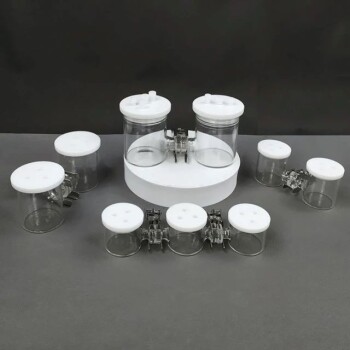Introduction to Electrochemistry and Its Importance
Electrochemistry is a branch of chemistry that deals with the study of the relationship between electrical energy and chemical reactions. It involves the transfer of electrons between two substances through an electrochemical cell. Electrochemistry is important because it helps us understand the behavior of materials and substances in different environments. It also plays a crucial role in many industries, such as battery manufacturing, corrosion prevention, and wastewater treatment. Additionally, electrochemistry is used in the development of new technologies and products, such as fuel cells and solar cells.
Table of Contents
- Introduction to Electrochemistry and Its Importance
- Definition of Electrochemical Cells
- Types of Electrochemical Cells (Galvanic and Electrolytic)
- Working of Galvanic Cells
- Components of Electrolytic Cells
- Working of Electrolytic Cells
- Importance of Redox Reactions in Electrochemistry
- Applications of Electrochemical Cells in Society
Definition of Electrochemical Cells
Electrochemistry is the branch of chemistry that studies the relationship between electrical energy and chemical change. An electrochemical cell is a device that is capable of either generating electrical energy from chemical reactions or facilitating chemical reactions through the introduction of electrical energy.

What are Electrochemical Cells?
An electrochemical cell is the smallest functional unit of an electrochemical system. It utilizes the principles of electrochemistry to generate electrical energy or facilitate chemical reactions. Electrochemical cells are of two types: galvanic cells (or voltaic cells) and electrolytic cells. Both types of cells contain two electrodes, an anode and a cathode, which are connected to each other with an external electrical connection, such as a wire, to allow electrons to flow from the anode to the cathode. The electrodes are also connected by an electrolyte, an ionic substance or solution that allows ions to transfer between the electrodes.

Galvanic Cells
Galvanic cells are driven by a spontaneous flow of electrons to produce an electric current. They convert chemical energy into electrical energy. The reaction in galvanic cells is spontaneous and the cathode is the positive electrode, while the anode is the negative electrode. Electrons move from the anode to the cathode through an external circuit, and ions are discharged at the cathode while they are consumed at the anode.
Electrolytic Cells
Electrolytic cells, on the other hand, require an input of electrical energy to drive the chemical reaction inside the cell. They convert electrical energy into chemical energy. The reaction in electrolytic cells is non-spontaneous and the anode is the positive electrode, while the cathode is the negative electrode. Electrons move from the cathode to the anode through an external circuit, and ions are discharged at both the electrodes.
Cell Potential
The difference in potential between the two electrodes is called the cell potential, and it is a measure of the ability of the cell to produce or consume electrical energy. The cell potential is influenced by a number of factors, including the nature of the electrodes, the concentration of the electrolyte solution, and the temperature of the system.
Conclusion
Electrochemical cells are important in society today, especially in terms of energy storage. They are the basis for devices like batteries and fuel cells. Understanding the science behind electrochemical cells is essential for the development of new and improved technologies that rely on the conversion of chemical energy into electrical energy or vice versa.
Types of Electrochemical Cells (Galvanic and Electrolytic)
Electrochemical cells are devices that convert chemical energy into electrical energy or vice versa. There are two main types of electrochemical cells: Galvanic cells and electrolytic cells.

Galvanic Cells
Galvanic cells, also known as voltaic cells, are devices that generate electrical energy from a spontaneous chemical reaction. In galvanic cells, chemical energy is converted into electrical energy. An example of a galvanic cell is a battery. The galvanic cell mostly has two types of metals in each of the electrolyte solutions which are connected by using a salt bridge. Galvanic cells have an anode (negative) and a cathode (positive) electrode. When electrons shift from species to species through a spontaneous redox reaction, energy is released. This energy can be used to perform tasks when the reaction is divided into two half-reactions which are oxidation and reduction. These two reactions are carried out in two separate containers and a wire is used as a bridge between the two containers to take electrons from one container to another. By this, a galvanic or voltaic cell is formed.
Electrolytic Cells
Electrolytic cells are devices that use electrical energy to drive a non-spontaneous chemical reaction. In electrolytic cells, electrical energy is converted into chemical energy. An example of an electrolytic cell is an electroplating cell. Electrolytic cells are used to decompose elements, i.e., to break them into different elements. The type of electrochemical cells that produce a chemical reaction are electrolytic cells. In electrolytic cells, an external source of electrical energy is required to drive the chemical reaction. Electrolytic cells have a cathode and an anode. The cathode is the electrode at which electrons are accepted or consumed, while the anode is an electrode at which the electrons are released or liberated.
Differences between Galvanic and Electrolytic Cells
The main difference between galvanic and electrolytic cells is that galvanic cells generate an electric current from chemical reactions, while electrolytic cells use electric current to drive chemical reactions. Galvanic cells are used in batteries, while electrolytic cells are used in the electroplating and purification of metals such as copper. Galvanic cells are spontaneous reactions, while electrolytic cells are non-spontaneous. Another difference is the direction of electron flow. In a galvanic cell, the electron flows from anode to cathode through the external circuit, while in an electrolytic cell, the electron flows from cathode to anode through the external circuit.
In conclusion, electrochemical cells have a wide range of applications, and understanding the principles of electrochemistry and electrochemical cells is essential for the development of new technologies and materials that rely on electrochemical processes.
Working of Galvanic Cells
Galvanic cells, also known as voltaic cells, are devices that convert chemical energy into electrical energy. They have two half-cells, each with an electrode and an electrolyte. The half-cell with the more negative reduction potential is called the anode, while the half-cell with the more positive reduction potential is called the cathode.

Electrons flow from the anode to the cathode through an external circuit, while ions flow from the anode to the cathode through the electrolyte. This flow of electrons and ions creates an electrical potential difference, or voltage, between the two half-cells.
The voltage of a galvanic cell can be calculated using the standard reduction potentials of the half-reactions involved. The standard reduction potential is the tendency of a half-reaction to gain electrons and become reduced under standard conditions.
The anode of a galvanic cell is negatively charged, and the cathode is positively charged. The anode undergoes oxidation, losing electrons and becoming positively charged. The cathode undergoes reduction, gaining electrons and becoming negatively charged.
The overall reaction in a galvanic cell is spontaneous, meaning it occurs without the need for an external energy source. The spontaneity of the reaction is determined by the difference in reduction potentials between the anode and cathode.
Galvanic cells have many practical applications, including batteries, fuel cells, and electroplating. Batteries are devices that store chemical energy and convert it to electrical energy when needed. Fuel cells are devices that convert the chemical energy of a fuel directly into electrical energy. Electroplating is a process used to coat a metal object with a thin layer of another metal.
In conclusion, galvanic cells convert chemical energy into electrical energy through a spontaneous redox reaction. The anode of the cell is negatively charged and undergoes oxidation, while the cathode is positively charged and undergoes reduction. The voltage of the cell is determined by the difference in reduction potentials between the anode and cathode. Galvanic cells have many practical applications in industries such as batteries, fuel cells, and electroplating.
Components of Electrolytic Cells
Electrolytic cells are electrochemical devices designed to carry out electrolysis, which is the decomposition of an electrolyte through the passage of an electric current. Electrolytic cells are composed of three primary components: the cathode, the anode, and the electrolyte.
The Cathode
The cathode is the negatively charged electrode in an electrolytic cell. It is the site of a reduction reaction, where positively charged ions gain electrons and are reduced. The cathode is usually made of a metal, such as copper or platinum, that does not easily corrode or react with the electrolyte. In some cases, the cathode can also be made of inert materials such as graphite, which is commonly used in the industrial production of aluminum.
The Anode
The anode is the positively charged electrode in an electrolytic cell. It is the site of an oxidation reaction, where negatively charged ions lose electrons and are oxidized. The anode is usually made of a metal that is capable of oxidizing, such as zinc or iron. The anode can also be made of inert materials such as graphite, which is commonly used in the industrial production of chlorine gas.
The Electrolyte
The electrolyte is a solution of ions that conducts electricity in an electrolytic cell. It is usually made of a salt dissolved in water, such as sodium chloride or potassium hydroxide. The electrolyte allows the flow of ions between the cathode and the anode, allowing for the oxidation and reduction reactions to occur. The choice of electrolyte depends on the specific electrolysis process being carried out.
During electrolysis, the cathode and anode are connected to a power source, usually a battery or a direct current power supply. When a voltage is applied to the electrodes, positively charged ions move towards the cathode, while negatively charged ions move towards the anode. At the cathode, the positively charged ions gain electrons, reducing them to their elemental form. At the anode, the negatively charged ions lose electrons, oxidizing them to their elemental form or a compound.
In summary, the components of an electrolytic cell include the cathode, the anode, and the electrolyte. The cathode and anode are made of materials that allow for the reduction and oxidation reactions, respectively, while the electrolyte allows the flow of ions between the electrodes. Understanding the function of each component is essential to the successful operation of an electrolytic cell.
Working of Electrolytic Cells
Electrolytic cells are electrochemical cells that drive non-spontaneous redox reactions with electrical energy. The cells consist of two electrodes, a cathode, and an anode submerged in an electrolyte solution. When an external power source is connected to the electrodes, a flow of electrons occurs, allowing for the transfer of ions in the electrolyte solution.
Electrolysis
Electrolysis is a process that involves the use of direct electric current (DC) to break down typically stable or inert chemical substances. There are three major components of an electrolytic cell: an electrolyte, a cathode, and an anode. The electrolyte is usually a dissolved ion solution in water or other solvents, including molten salts like sodium chloride.
Charge-Transferring Events
When an external voltage is applied to the electrodes, the ions in the electrolyte are attracted to an electrode with the opposite charge. This allows charge-transferring events or faradaic or redox events to occur. An electrolytic cell can only break down a stable or inert chemical substance in a solution with an external electrical potential of the proper polarity and adequate magnitude.
Cathode and Anode Reactions
The cathode, which is negatively charged, attracts positively charged ions, while the anode, which is positively charged, attracts negatively charged ions. As the ions move towards the electrodes, they undergo reduction and oxidation reactions, respectively, resulting in the production of new chemical species. The overall reaction is driven by the external power source and can be controlled by adjusting the voltage and current.
Applications
Electrolytic cells are used in a variety of applications, including electroplating and the production of chemicals such as chlorine and hydrogen. They are used commercially in the electrorefining and electrowinning of several non-ferrous metals, including high-purity aluminum, copper, zinc, and lead.
Electrolytic Cell and Battery
The battery initially offers an electrical energy source by forcing electrons onto the cathode, which makes it negatively charged. The anode is also positively charged because electrons are taken out of it. An oxidation-reduction reaction is triggered as a result of this. An oxidation reaction happens at the anode, generating electrons drawn to the positive anode. Simultaneously, a reduction process occurs at the cathode, which consumes the electrons accumulated on the cathode.
Conclusion
Electrolytic cells are fascinating electrochemical cells that are used in a variety of applications. They provide us with a deeper understanding of the relationship between electricity and chemical reactions. By understanding the science behind electrolytic cells, scientists can develop new and innovative technologies that can benefit society in countless ways.
Importance of Redox Reactions in Electrochemistry
Redox reactions play a vital role in electrochemistry. They are the fundamental chemical reactions responsible for the conversion of chemical energy into electrical energy in electrochemical cells. In a redox reaction, one species loses electrons while the other gains electrons. This transfer of electrons is what produces an electric current in an electrochemical cell.
Redox Reactions in Batteries
Batteries are one of the most common applications of redox reactions in electrochemistry. In a battery, the oxidation and reduction reactions occur at the anode and cathode, respectively. During discharge, the anode undergoes oxidation, causing it to lose electrons, while the cathode undergoes reduction, causing it to gain electrons. The flow of electrons between the anode and cathode produces an electric current that can be used to power devices.
Redox Reactions in Corrosion Prevention
Redox reactions also play an important role in corrosion prevention. Corrosion is the process by which metals are degraded by chemical reactions with the environment. By applying an external voltage to a metal surface, it is possible to create a redox reaction that prevents corrosion. This process is called cathodic protection and involves the reduction of oxygen at the metal surface, which reduces the likelihood of corrosion.
Redox Reactions in Electroplating
Electroplating is another important application of redox reactions in electrochemistry. In electroplating, a metal ion in solution is reduced at the cathode, where it deposits onto a metal surface to form a thin layer. By controlling the voltage and current used in the process, it is possible to control the thickness of the plated metal layer.
Redox Reactions in Medicine
Redox reactions also have important applications in medicine. For example, the redox reactions that occur in the electron transport chain in cells are responsible for the production of ATP, the energy currency of cells. Additionally, redox reactions have been used in the development of various medical treatments, such as chemotherapy and radiation therapy.
In conclusion, redox reactions are essential to electrochemistry and have numerous practical applications. From batteries to corrosion prevention, electroplating to medicine, redox reactions play a vital role in our daily lives. Understanding the principles of redox reactions is crucial to the development of new technologies and the advancement of scientific knowledge.
Applications of Electrochemical Cells in Society
Electrochemical cells have revolutionized various fields and have become an integral part of our society. Some of the important applications of electrochemical cells are:
Batteries
Batteries are the most common application of electrochemical cells. They are used to power electronic devices such as smartphones, laptops, and cars. These cells convert chemical energy into electrical energy and are available in different sizes and shapes. Lithium-ion batteries are the most popular batteries used in electronic devices because of their high energy density and long life.
Fuel Cells
Fuel cells are another application of electrochemical cells that have gained importance in recent years. They convert hydrogen and oxygen into electricity and water, providing a clean and efficient source of energy. Fuel cells are used in various applications such as powering vehicles, buildings, and remote areas.
Electroplating
Electroplating is a process that uses electrochemical cells to apply a thin layer of metal onto a surface for protection or decoration. This process is widely used in the manufacturing industry to improve the durability and aesthetics of metal products. For example, electroplating is used to make jewelry, silverware, and car parts.
Corrosion Protection
Corrosion protection is an important application of electrochemical cells, preventing rust and deterioration of metal structures such as bridges, ships, and pipelines. This is achieved by using a process called cathodic protection, where a sacrificial anode is connected to the metal structure. The anode corrodes instead of the metal structure, protecting it from corrosion.
Sensors
Electrochemical cells have contributed to the development of new technologies, such as sensors for detecting chemical substances. These sensors use electrochemical reactions to detect the presence of a particular substance. For example, glucose sensors are used by diabetic patients to monitor their blood sugar levels.
Capacitors
Electrochemical capacitors are another application of electrochemical cells for energy storage. These devices store electrical energy using a process called double-layer capacitance. They have a high power density and can be charged and discharged quickly. Electrochemical capacitors are used in various applications such as electric vehicles, renewable energy systems, and power backup systems.
In conclusion, electrochemical cells have a wide range of applications in our society, providing us with a range of useful applications that improve our daily lives. These applications have become essential in various fields, and their importance is expected to increase in the future.
Related Products
- H Type Electrolytic Cell Triple Electrochemical Cell
- Electrolytic Electrochemical Cell for Coating Evaluation
- Flat Corrosion Electrolytic Electrochemical Cell
- Side Window Optical Electrolytic Electrochemical Cell
- Quartz Electrolytic Electrochemical Cell for Electrochemical Experiments
Related Articles
- Understanding Electrolytic Cells: Conversion of Energy and Applications
- Understanding Quartz Electrolytic Cells: Applications, Mechanisms, and Advantages
- Understanding Electrolytic Cells and Their Role in Copper Purification and Electroplating
- The Silent Variable: Engineering Reliability in Electrolytic Cells
- Applications of H-Type Electrolytic Cell in Metal Extraction












